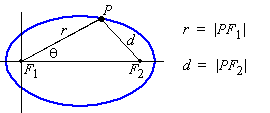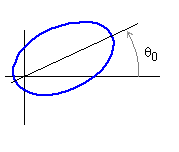Ellipses in Polar Coordinates
Let's suppose that 2 ''nails'' are driven into a board at points F1 and F2, and suppose that the ends of a string of length 2a is
attached to the board at points F1 and F2. If the string is pulled
tight around a pencil's tip, then the points P traced by the pencil as
it moves within the string form an ellipse.
 |
|
click image to toggle animation |
|
Specifically, an ellipse is the locus of all points P such that
where | PF1| and | PF2| denote distances
from P to F1 and F2, respectively. The points F1 and F2
are called the foci of the ellipse, and the distance a is called
the semi-major axis.
Let's use this definition of an ellipse to derive its representation in
polar coordinates. To begin with, let's assume that F1 is at the origin
and that F2 is on the positive real axis. Then the distance |PF1| is the same as the r in polar coordinates

Let's use this definition of an ellipse to derive its representation in
polar coordinates. To begin with, let's assume that F1 is at the origin
and that F2 is on the positive real axis at the point (2c,0) (i.e., 2c is the distance from F1 to F2). Then r is the polar vector to the point P, and r-2ci is the vector from F2 to P.
The ellipse definition implies that
Thus, r = ||r|| implies that r-2a = ||r-2ci||, so that
However, r =
á rcos( q) ,rsin(q)
ñ implies that
|
|
|
|
( rcosq-2c)2 + ( r sinq)2 |
| |
|
|
r2cos2( q) - 2rccos( q) + 4c2 + r2sin2( q) |
| |
|
|
|
Simplifying and solving for r yields
If we let b2 = a2-c2 denote the square of the semi-minor axis, then
Finally, let us divide by a to obtain
Usually, we let e = c/a and let p = b2/a, where e
is called the eccentricity of the ellipse and p is called the
parameter. It follows that 0 £ e < 1 and p > 0, so that an
ellipse in polar coordinates with one focus at the origin and the other on
the positive x-axis is given by
Moreover, b2 = a2-c2 implies that
|
p = a |
æ
è
|
|
b2
a2
|
ö
ø
|
= a |
æ
è
|
|
a2-c2
a2
|
ö
ø
|
= a |
æ
è
|
1- |
c2
a2
|
ö
ø
|
, |
|
which in turn implies that p = a( 1-e2) .
EXAMPLE 7 Find the center, semi-major axis, semi-minor axis
and foci of the ellipse
What is the Cartesian equation of the ellipse?
Solution: Since p = 3 and e = 0.5, the formula p = a( 1-e2 ) implies that
As a result, b2 = ap implies that
|
b2 = 4·3 = 12, b =
Ö12
= 2Ö3 |
|
Finally, the focus F1 is at the origin and the calculation
implies that F2 is at the point ( 4,0) on the x-axis.
To convert to x and y, we first multiply to get
Thus, 5r = 4rcos( q) +9, so that
Since ( 4x+9) 2 = 16x2+72x+81, we have
which yields 9x2-72x+25y2 = 81.
Finally, had F2 been placed on the positive y-axis, the
negative x-axis, or the negative y-axis, the polar equation of the
ellipse would be modified by replacing cos( q) with sin( q) , -cos( q) , or -sin( q) , respectively.
|
Polar ellipses with F2 on the given
axis and F1 = (0,0) |
| positive x-axis: |
|
|
positive y-axis: |
|
|
|
|
|
|
| negative x-axis: |
|
|
negative y-axis: |
|
|
|
Indeed, the most general form of an conic with parameter p and
eccentricity e > 0 is
where it can be shown that a = ecos( q0)
and b = esin( q0) . It follows that the
conic is symmetric about the line at angle q0 to the x-axis.

EXAMPLE 8 Find the center, semi-major axis, semi-minor axis
and foci of the ellipse
Solution: Let's divide the numerator and denominator by 5 to obtain
Since p = 16/5 and e = 3/5, the formula p = a( 1-e2 ) implies that
As a result, b2 = ap implies that
|
b2 = 5 · |
 |
16
5
|
 |
= 16, b = 4 |
|
Finally, the focus F1 is at the origin and the table above
implies that F2 is on the negative y-axis. Since
implies that F2 is at the point ( 0, -6).



